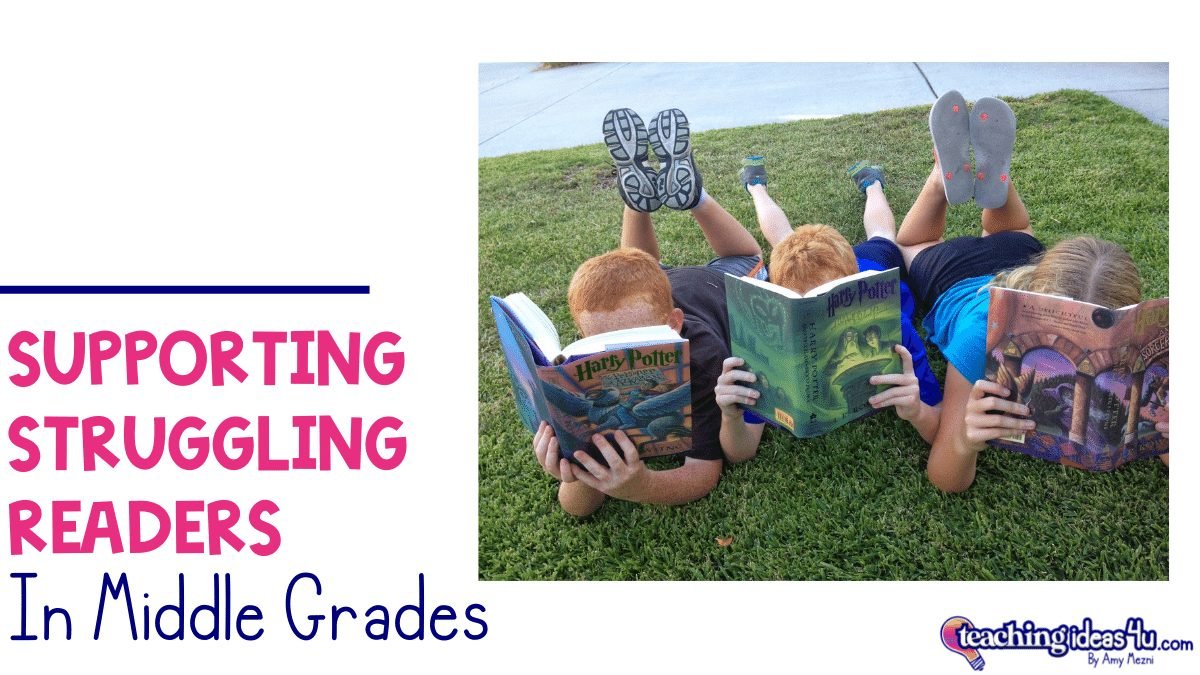Supporting Struggling Readers in Middle Grades
As I discussed in last week’s post, students who fall behind in reading comprehension in first grade rarely catch up to the level of students who were on grade level. Struggling readers tend to develop anxiety and poor self-esteem regarding their reading abilities as they fall further and further behind in school.
Students often cover their lack of comprehension with other behaviors. For example, some students will withdraw in class, while others will act out to deflect attention from their reading.
Supporting Struggling Readers
The good news is that upper elementary and middle school students with reading disabilities can make great gains with effective interventions and classroom materials on their level. With targeted interventions and a supportive classroom environment, these students can begin to feel successful, which in turn helps motivate them to try.
Classroom Environment
A few things teachers can do to support struggling readers are:
Make their classroom a safe space where students can ask questions without being embarrassed.
Build strong teacher-student relationships to build trust.
Stop forcing students to read aloud in front of peers. Instead, use choral reading, where students read together.
Mix up small group work so low readers are not always together. Use homogeneous groups when focusing on a reading school (that you have identified the students need) but heterogeneous groups when working on other skills.
Avoid judging students - such as calling them lazy for not doing their work.
Provide audiobooks as much as possible so that students can access the grade-level material.
Give students grade-level work but provide scaffolding to help them understand the content.
Use texts that appear age-appropriate - do not give middle school students texts that look like first-grade readers.
Integrate students’ strengths into classwork. Provide Choice Boards or use your knowledge of students to create assessments. For example, if you have a talkative class, allow them to create videos or interviews. For an artistic class, perhaps you could have them make posters or comics.
Targeted Interventions
Interventions should be based on students’ skills and learning deficits. Hopefully, the school has someone who does the screenings and can convey this information to teachers. Generally, students with reading comprehension issues will need support beginning in one of the following areas:
Strengthen phonics and decoding, including but not limited to phonics, multisyllabic word reading (syllables and vowel patterns), and structural analysis of words (stems, prefixes, and suffixes.)
Reading fluency and word recognition in texts.
Vocabulary deficiencies.
Reading comprehension strategies, such as visualizing and inferencing.
But I Don't Teach Reading
As a content teacher, I know my biggest concern was how would I cover my content - which I already did not have enough time for - if I now had to teach reading?
Ideally, middle school teachers would team and share data on students. That would allow teachers to also coordinate reading interventions. Unfortunately, school schedules do not always provide time for teaming in this manner.
I had to do a mind shift and realize that I was teaching reading in my content area - otherwise, students would not understand a lot of the information. No matter what the subject is, teachers need to teach comprehension strategies so that students can reach a deep understanding of the material.
Adding reading scaffolding and targeted interventions to your classroom may look different than you imagine. In fact, you probably already use some forms of support in your classes. I brainstormed a quick list of possible reading support I might use in a middle school social studies class:
Using videos in a unit of study (audio/visual support.)
Explicitly teaching vocabulary, including the Greek or Latin roots of words.
Scaffolding background knowledge.
Using lesson warm-ups to help relate the lesson subject to a topic students already know.
Using teacher think aloud, where I discuss what I visualize in my head as I read a section of text.
Creating notes with students as/after we read text or teacher model note taking.
Use think-pair-share.
Include a student choice component in formative or summative assessments. (Not necessarily on every single one, but sometimes.)
Breaking content into smaller chunks to make it easier to process the information.
Using centers to include different learning styles and modalities and to break content into smaller chunks.
Using formative assessments (like exit tickets) to determine reteaching needs.
When possible, use the same text on different reading levels to meet students’ reading levels.
It is important that any support provided to low readers helps them to learn and achieve on grade level. All students should be expected to demonstrate grade-level mastery of content skills, regardless of their reading comprehension level.
“Dumbing down” the work does not help students achieve on grade level. Remember, low reading comprehension is not indicative of a student’s ability.
Don't Give Up
When students are supported with scaffolding and finally realize that they can succeed, often teachers will see a whole new student emerge. Remember, students that struggle with reading comprehension have been failing for years. Many have given up after trying and trying but not seeing any success.
Teachers need to help these students see that they can be successful. It is not necessarily fast or easy to convince students they can do well if they just try - after all, they have failed repeatedly even when they tried before.
If you want to learn more, a good resource for more information is the ERIC document Who’s Really Struggling?: Middle School Teachers’ Perceptions of Struggling Readers by Leah K. Moreau.
Also, if you don’t use mastery grading, I recommend considering it for your classroom. For more information, check out my blog series here.

